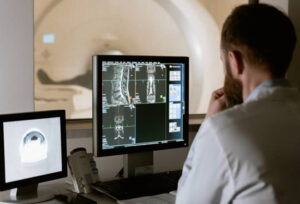Duplex ultrasound helps study the blood flow in your arms and legs’ major veins and arteries. It includes high-pitched sound impressions to measure the speed of your blood flow and assembly of the arm and leg veins. Let’s get into more elaborated details on a duplex color-flow ultrasound.
Duplex Color-Flow Ultrasound
 The term duplex itself refers to the fact that two distinct modes of ultrasound are used: Doppler and B-mode. The B-mode transducer is similar to a microphone. It helps obtain an image of the vessel under observation. The doppler analysis within the transducer evaluates the velocity and direction of blood flow in the vessel. It records sound impressions imitating stirring matters, including blood and how it gushes. There are several forms of duplex ultrasound tests.
The term duplex itself refers to the fact that two distinct modes of ultrasound are used: Doppler and B-mode. The B-mode transducer is similar to a microphone. It helps obtain an image of the vessel under observation. The doppler analysis within the transducer evaluates the velocity and direction of blood flow in the vessel. It records sound impressions imitating stirring matters, including blood and how it gushes. There are several forms of duplex ultrasound tests.
The key ones are:
- A venous and arterial stomach ultrasound, which helps examine the blood vessels and course in the intestinal area.
- Duplex ultrasound of the hands and feet, which studies the blood flow in the arms and legs.
- A carotid duplex ultrasound, which scans the carotid artery in your neck.
- Renal duplex ultrasonography, which helps to study a patient’s kidney and blood vessels.
The Process
You will be required to wear a checkup robe and be made to lie on a stand. The ultrasonography specialist will then put gel on the specific area. The gel benefits the sound impressions, so they get deep into your tissues, making them easier to examine. A transducer (wand) is then rolled on the particular area. It sends out sound impressions. The sound impressions are then measured and reflected onto the computer in pictures. The swishing sound that the doppler creates is your blood flowing in your veins and arteries.
You will be instructed to remain motionless throughout most of this procedure. However, you will need to move when being tested in different areas. You can be told to take a deep breath and hold on to it for a while.
Why Is the Test Performed
A duplex ultrasound helps show blood flow to most body parts. Therefore, it is an excellent way to examine a blood vessel and reveal any blockages. This test is performed to help diagnose the following conditions:
- Blood clots
- Abdominal aneurysm
- Varicose veins
- Arterial narrowing (stenosis) or blockage (occlusion)
- Venous insufficiency
- Carotid occlusive disease
- Renal vascular disease
Test Preparation
You don’t need to plan for the assessment unless you get an ultrasound done on your stomach. Then you can be instructed not to have anything after midnight. However, you need to inform your doctor about ongoing medicine courses as they might impact your results. The test is not painful, nor will it provide you discomfort. You will only get slight sensations in the areas where the wand is moving.
The test then helps provide relevant information to help your vascular surgeon make an accurate diagnosis and outline a treatment plan. It is crucial to have an accurate duplex ultrasound. Thus, it must always be performed by a credentialed sonographer in an accredited vascular laboratory.
